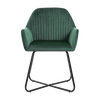Filing cabinets for all your storage needs
Filing cabinets provide storage space for office documents that often pile up on your desk. From top companies to startups, every level of business needs some storage. Even in today’s technologically advanced world where people are storing documents online, file cabinets still have a vital role to play in offices. These units are essential in organising everything from documents and equipment to office supplies.
Whether you want to keep your home office documents organised or you’re simply looking for the ideal storage solution for your private files, our range of top-class file cabinets will meet your needs. We have file cabinets in a wide range of shapes, sizes and materials, so you’re sure to find something that works for you.
Browse our extensive collection to find the right filing cabinet that will keep all your important documents safe and organised.
Different types of filing cabinets
When looking for a file cabinet, consider the office space you have and the type of storage you need. Document sizes also influence your choice of a filing cabinet. There are a few types of filing cabinets to choose from. Let’s take a closer look to help you understand the different types of file cabinets.
-
Lateral file cabinet: Also known as horizontal office cabinets, lateral cabinets provide enough storage to accommodate more paperwork. They usually have two drawers, although you can find units with three or more sections. Their ability to hold more documents makes them ideal for busy and highly competitive work environments. An anti-tipping feature on these file cabinets prevents them from tipping over when you pull a drawer all the way out. These cabinets can also store both legal- and letter-size hanging folders.
-
Vertical file cabinet: Vertical filing cabinets require less wall space, which makes them a great choice for compact spaces. Essentially, they don’t store as many documents as lateral filing cabinets, but you can find models with a larger number of drawers. They have narrower drawers and can only hold letter-size folders. These file cabinets are more common in home offices.
-
Mobile file cabinet: As the name suggests, mobile file cabinets offer a convenient storage solution as they can be moved from one location to another. They are a good option for people who want to maximise storage without taking up much floor space. Wheels attached to the bottom drawer allow for easy movement and provide stability to the structure. Mobile file cabinets can hold both letters and legal papers.
-
Open shelf file cabinet: Open shelf filing cabinets look like a bookshelf. They have an open front design, which enables them to hold end-tab folders with ease. Open shelf cabinets are suited for small spaces or narrow aisles. They are mostly found in pharmaceutical shops and hospitals.
-
Flat file cabinet: Flat file cabinets have shallow drawers stacked on top of each other. Ideal for storing large, flat items, these file cabinets provide a great storage solution for blueprints. They do not provide large storage but could be what you need for oddly shaped files.
Which material should you choose for your filing cabinet?
One of the most important choices you will need to make when looking for an office cabinet for your office is the material it’s made from. Office storage cabinets come in different materials, including metal, wood, steel and others. As you would expect, these materials have their own advantages and disadvantages. Let's have a look at the three most common materials.
-
Wood: A timeless classic, wood file cabinets will bring a traditional vibe to your office. Wood is generally strong and robust. With proper care, wood file cabinets should last for many years. You can buy these models in different finishes and colours to match your décor. You can never go wrong with wood office furniture.
-
Engineered wood: Filing cabinets made from engineered wood make great alternatives to solid wood file cabinets. These cabinets will give your office that traditional look you expect from their solid wood counterparts. They also easily blend into your existing décor.
-
Metal: Typically offered in steel and aluminium options, metal file cabinets are strong. They can hold large files. For this reason, they are more common in sectors that keep records for long periods of time. Metal filing cabinets are more resistant to water and fire damage. They may not be available in the sleek finishes of wood cabinets, but they come in a range of colours to compliment your office design.
6 tips for organising your office space
An organised office space is not only visually pleasing but also essential for productivity and efficiency. With the right strategies in place, you can transform your workspace into a well-oiled machine where tasks flow seamlessly. Here are six tips to help you keep your office organised and optimised for success.
-
Invest in a filing cabinet: Purchase a filing cabinet to store important documents and paperwork. Categorise files logically, such as by client, project or department. Label each drawer clearly for easy identification and retrieval of documents.
-
Embrace labels: Label everything from file folders to storage bins to maintain clarity and organisation. Use consistent labelling methods throughout the office to avoid confusion. Consider colour-coded labels for different categories or priority levels.
-
Establish a set place for everything: Designate specific locations for frequently used items like pens, staplers and notepads. Encourage colleagues to adhere to the same organisation system to promote consistency. Return items to their designated place after each use to prevent clutter from accumulating.
-
Maximise vertical space: Install shelves or wall-mounted organisers to utilise vertical space efficiently. Store books, binders and decorative items on shelves to free up desk space. Utilise hanging file organisers to keep important documents easily accessible and off your desk.
-
Digital organisation is key: Organise digital files into folders on your computer or cloud storage platform. Use descriptive file names and create a logical folder structure for easy navigation. Regularly backup important documents and delete outdated files to keep your digital workspace clutter-free.
-
Implement a daily cleanup routine: Dedicate a few minutes at the end of each day to tidy up your workspace. Clear off your desk, dispose of trash and put away any items that are out of place. A clean and organised workspace will set a positive tone for the next day.
Incorporating these six tips into your office routine will help you create an organised workspace that fosters productivity and creativity.
Tips for decorating your workspace
Decorating your office goes beyond just style; it can significantly impact your mood, productivity and overall well-being. Here are some tips to help you decorate your office space effectively.
-
Get a good desk and chair: Choose a desk and chair that are comfortable to support long hours of work. Opt for adjustable features to customise the height and position according to your needs. Select a desk with enough surface area and storage options to keep your workspace organised.
-
Incorporate functional furniture pieces: Include a filing cabinet or storage unit to keep important documents and supplies organised and easily accessible. Consider multipurpose furniture pieces like ottomans with hidden storage or desks with built-in shelves to maximise space. Balance functionality with style by choosing furniture that compliments your office décor.
-
Bring nature indoors with plants: Add a touch of greenery to your office with low-maintenance plants. Plants not only improve air quality but also create a calming and inviting atmosphere. Place plants strategically around your workspace to enhance visual appeal and promote a sense of well-being.
-
Personalise your space with decorative accents: Display artwork, photographs or motivational quotes that resonate with you to personalise your office. Incorporate decorative accents such as throw pillows, rugs or desk accessories to add personality and warmth to your space. Choose décor elements that inspire and uplift you to create a positive work environment.
-
Illuminate your workspace: Ensure adequate lighting in your office by incorporating a combination of natural light and artificial lighting. Position your desk near a window to maximise natural light exposure and reduce eye strain. Supplement natural light with task lighting such as desk lamps or overhead lights to illuminate specific areas of your workspace.
By implementing these decorating tips, you can transform your office into a functional space that supports your work habits and enhances your productivity.
Looking for other products? Check out the categories below:
Colour: Black filing cabinet - White filing cabinet
Type: Small filing cabinets - Tall filing cabinet































































